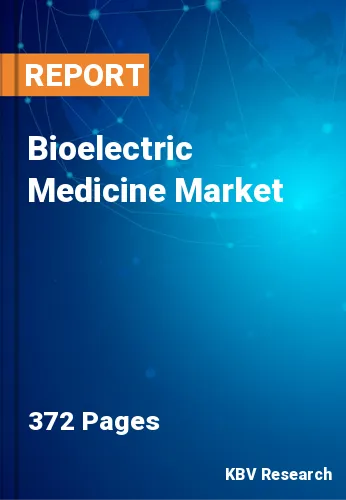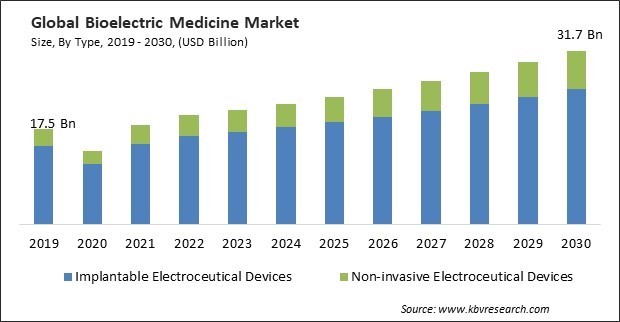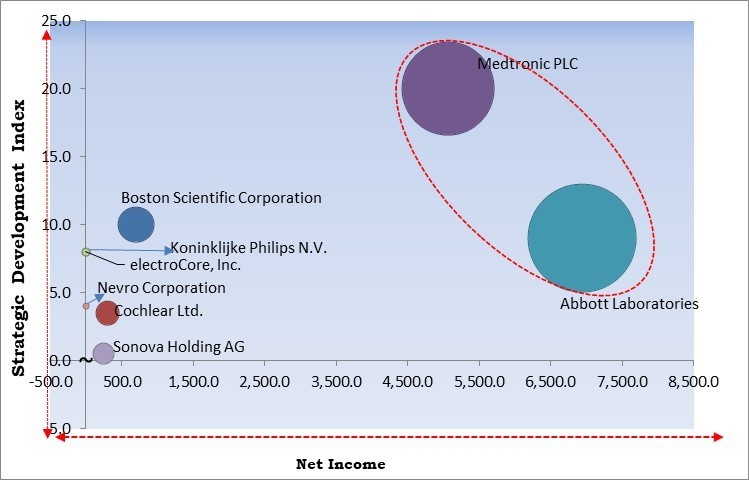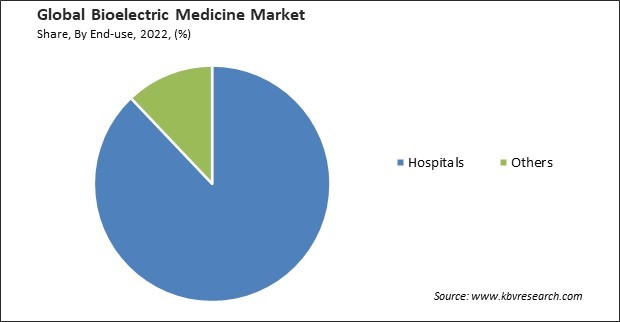
The Global Bioelectric Medicine Market size is expected to reach $31.7 billion by 2030, rising at a market growth of 6.1% CAGR during the forecast period.
Deep brain stimulation (DBS) is a well-established technique involving implanted electrodes to deliver electrical impulses to specific brain regions, providing therapeutic benefits in conditions like Parkinson's disease. Therefore, Deep Brain Stimulators segment generated $1,022.1 million revenue in the market in 2022. Likewise, neuromodulation techniques, such as transcranial magnetic stimulation (TMS), and deep brain stimulation, are being explored for their potential in various neurological and psychiatric disorders. These techniques aim to modulate neural activity to restore normal functioning and alleviate symptoms. These aspects will lead to increased demand in the market.

The major strategies followed by the market participants are Partnerships, Collaborations & Agreements as the key developmental strategy to keep pace with the changing demands of end users. For instance, In August, 2021, electroCore, Inc. signed an agreement with Red One Medical Devices, LLC, a service-disabled veteran-owned small business. This agreement aimed to widen the availability of electroCore’s gammaCore platform in the federal marketplace. Moreover, In May, 2020, Medtronic collaborated with UW following which the company has accelerated research into deep brain stimulation treatment for essential tremor, Parkinson’s disease, and other neurological disorders.
Based on the Analysis presented in the KBV Cardinal matrix; Abbott Laboratories and Medtronic PLC are the forerunners in the Market. In November, 2021, Medtronic PLC partnered with Rune Labs, a company using aggregated brain data to empower the development and delivery of precision medicines for neurological and psychiatric diseases. This partnership aimed to assess the use of BrainSense technology, the first and only complete Deep Brain Stimulation system able to chronically capture and record brain signals. Companies such as Boston Scientific Corporation, Nevro Corporation and electroCore, Inc. are some of the key innovators in the Market.

The pandemic disrupted global supply chains, affecting the production and distribution of bioelectric devices and components. Lockdowns, travel restrictions, and workforce challenges led to delays in manufacturing and supply, impacting the availability of certain bioelectric technologies. Many research and development activities in the market experienced delays as laboratories were temporarily closed, and resources were redirected toward COVID-19-related research. Clinical trials for new bioelectric therapies faced interruptions, affecting timelines for product development. Therefore, the COVID-19 pandemic led to a negative impact on the market.
The aging process is associated with an increased risk of chronic diseases such as cardiovascular disorders, neurodegenerative conditions (like Alzheimer's and Parkinson's diseases), arthritis, and other age-related ailments. Bioelectric interventions, through their potential to modulate physiological processes, can offer novel approaches to manage and treat these conditions effectively. Bioelectric medicine aims not only to treat diseases but also to enhance the overall quality of life. Bioelectric interventions, including neuromodulation and other techniques, can improve these aspects and promote a better quality of life for elderly individuals. These factors will help in the expansion of the market.
Investment in research helps navigate regulatory pathways for approval and commercialization. Meeting regulatory standards is crucial for bringing bioelectric therapies to the market, and ongoing investment supports the necessary studies and documentation to meet these requirements. The commitment of resources from industry leaders contributes to expanding the market. As new therapies are developed and proven effective, they can reach a broader patient population, increasing market penetration. Therefore, these factors will pose lucrative growth prospects for the market.
Bioelectric companies looking to market their products internationally face the challenge of navigating multiple regulatory frameworks. Differences in approval processes and requirements across regions can add complexity and length to the overall regulatory timeline. Regulatory agencies may face challenges in adapting existing frameworks to accommodate rapidly evolving technologies in bioelectric medicine. The novelty and uniqueness of some bioelectric therapies may require regulatory agencies to develop specialized guidelines. These elements will hamper the growth of the market.
By type, the market is bifurcated into implantable electroceutical devices and non-invasive electroceutical devices. In 2022, the non-invasive electroceutical devices segment witnessed a substantial revenue share in the market. Non-invasive electroceutical devices provide a patient-friendly alternative to invasive procedures. Patients often prefer non-invasive treatments due to reduced pain, minimal discomfort, and the absence of surgical interventions. This approach enhances patient compliance and contributes to a positive patient experience. Technological advancements have been crucial in developing sophisticated, non-invasive electroceutical devices. Innovative technologies, such as transdermal electrical stimulation and non-invasive neuromodulation, have expanded the scope of non-invasive interventions. Therefore, the segment will expand rapidly in the upcoming years.
On the basis of end-use, the market is divided into hospitals and others. The hospitals segment recorded the maximum revenue share in the market in 2022. Bioelectric interventions are finding applications across various medical specialties, ranging from neurology and pain management to cardiology and rehabilitation. The versatility of bioelectric therapies makes them relevant for addressing diverse medical conditions, prompting hospitals to explore and implement these interventions within various departments. Thus, these factors will fuel the growth of the hospitals segment.

Based on product, the market is segmented into implantable cardioverter defibrillators & cardiac pacemakers, cochlear implants, spinal cord stimulators, deep brain stimulators, transcutaneous electrical nerve stimulators, sacral & vagus nerve stimulators, and others. In 2022, the spinal cord stimulators segment garnered a significant revenue share in the market. Spinal cord stimulators are often used as a therapeutic option for managing chronic pain conditions, such as failed back surgery syndrome and complex regional pain syndrome. The rising prevalence of these conditions, coupled with a growing aging population, can contribute to an increased demand for spinal cord stimulators. Therefore, the segment will expand rapidly in the coming years.
Based on application, the market is divided into arrhythmia, pain management, sensorineural hearing loss, Parkinson’s disease, tremor & epilepsy, depression, treatment-resistant depression, urinary & fecal incontinence, and others. In 2022, the tremor and epilepsy segment witnessed a substantial revenue share in the market. Tremors and epilepsy often involve abnormal electrical activity in the brain. Neuromodulation therapies, a significant component of bioelectric medicine, involve the use of electrical stimulation to modulate neural activity. Advances in neuromodulation technologies may lead to more effective treatments for conditions such as tremors and epilepsy. These factors will lead to rapid expansion of the segment.
| Report Attribute | Details |
|---|---|
| Market size value in 2022 | USD 20.5 Billion |
| Market size forecast in 2030 | USD 31.7 billion |
| Base Year | 2022 |
| Historical Period | 2019 to 2021 |
| Forecast Period | 2023 to 2030 |
| Revenue Growth Rate | CAGR of 6.1% from 2023 to 2030 |
| Number of Pages | 372 |
| Number of Tables | 525 |
| Report coverage | Market Trends, Revenue Estimation and Forecast, Segmentation Analysis, Regional and Country Breakdown, Competitive Landscape, Porter’s 5 Forces Analysis, Company Profiling, Companies Strategic Developments, SWOT Analysis, Winning Imperatives |
| Segments covered | Type, Product, Application, End-use, Region |
| Country scope |
|
| Companies Included | Medtronic PLC, Abbott Laboratories, Boston Scientific Corporation, Cochlear Ltd., LivaNova PLC, Koninklijke Philips N.V., Biotronik SE & Co. KG, Sonova Holding AG, Nevro Corporation, and electroCore, Inc. |
| Growth Drivers |
|
| Restraints |
|
By region, the market is segmented into North America, Europe, Asia Pacific, and LAMEA. The North America segment procured the highest revenue share in the market in 2022. North America, particularly the United States, has been a significant player in the healthcare industry, with a robust industry for medical technologies and innovations. The region has been at the forefront of bioelectric medicine research and development. Academic institutions, research centers, and industry collaborations often drive innovation, leading to the development of novel bioelectric therapies and devices. Thus, the segment will witness increased growth in the coming years.
Free Valuable Insights: Global Bioelectric Medicine Market size to reach USD 31.7 billion by 2030
The market research report covers the analysis of key stake holders of the market. Key companies profiled in the report include Medtronic PLC, Abbott Laboratories, Boston Scientific Corporation, Cochlear Ltd., LivaNova PLC, Koninklijke Philips N.V., Biotronik SE & Co. KG, Sonova Holding AG, Nevro Corporation, and electroCore, Inc.
By Type
By End-use
By Product
By Application
By Geography
This Market size is expected to reach $31.7 billion by 2030.
Growing aging population globally are driving the Market in coming years, however, Challenges related to regulatory approval restraints the growth of the Market.
Medtronic PLC, Abbott Laboratories, Boston Scientific Corporation, Cochlear Ltd., LivaNova PLC, Koninklijke Philips N.V., Biotronik SE & Co. KG, Sonova Holding AG, Nevro Corporation, and electroCore, Inc.
The expected CAGR of this Market is 6.1% from 2023 to 2030.
The Implantable Electroceutical Devices segment is generating the highest revenue in the Market by Type in 2022; thereby, achieving a market value of $24.7 billion by 2030.
The North America region dominated the Market by Region in 2022, and would continue to be a dominant market till 2030; thereby, achieving a market value of $12.9 billion by 2030.
Our team of dedicated experts can provide you with attractive expansion opportunities for your business.
